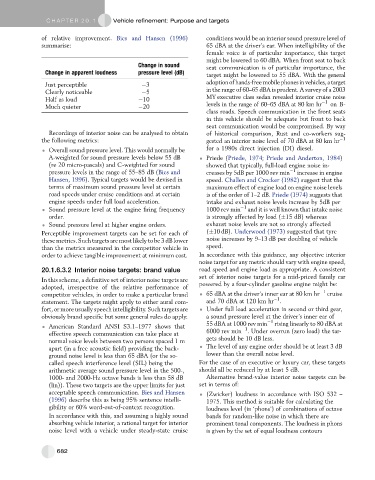Page 671 - Automotive Engineering Powertrain Chassis System and Vehicle Body
P. 671
CHAP TER 2 0. 1 Vehicle refinement: Purpose and targets
of relative improvement. Bies and Hansen (1996) conditions would be an interior sound pressure level of
summarise: 65 dBA at the driver’s ear. When intelligibility of the
female voice is of particular importance, this target
might be lowered to 60 dBA. When front seat to back
Change in sound
seat communication is of particular importance, the
Change in apparent loudness pressure level (dB)
target might be lowered to 55 dBA. With the general
Just perceptible 3 adoption of hands-free mobile phones in vehicles, atarget
Clearly noticeable 5 in the range of 60–65 dBA is prudent. A survey of a 2003
Half as loud 10 MY executive class sedan revealed interior cruise noise
1
Much quieter 20 levels in the range of 60–65 dBA at 80 km hr on B-
class roads. Speech communication in the front seats
in this vehicle should be adequate but front to back
seat communication would be compromised. By way
Recordings of interior noise can be analysed to obtain of historical comparison, Rust and co-workers sug-
the following metrics: gested an interior noise level of 70 dBA at 80 km hr 1
Overall sound pressure level. This would normally be for a 1980s direct injection (DI) diesel.
A-weighted for sound pressure levels below 55 dB Priede (Priede, 1974; Priede and Anderton, 1984)
(re 20 micro-pascals) and C-weighted for sound showed that typically, full-load engine noise in-
pressure levels in the range of 55–85 dB (Bies and creases by 5dB per 1000 rev min 1 increase in engine
Hansen, 1996). Typical targets would be devised in speed. Challen and Crocker (1982) suggest that the
terms of maximum sound pressure level at certain maximum effect of engine load on engine noise levels
road speeds under cruise conditions and at certain is of the order of 1–2 dB. Priede (1974) suggests that
engine speeds under full load acceleration. intake and exhaust noise levels increase by 5dB per
Sound pressure level at the engine firing frequency 1000 rev min 1 and it is well known that intake noise
order. is strongly affected by load ( 15 dB) whereas
Sound pressure level at higher engine orders. exhaust noise levels are not so strongly affected
Perceptible improvement targets can be set for each of ( 10 dB). Underwood (1973) suggested that tyre
these metrics. Such targetsare most likely to be 3 dB lower noise increases by 9–13 dB per doubling of vehicle
than the metrics measured in the competitor vehicle in speed.
order to achieve tangible improvement at minimum cost. In accordance with this guidance, any objective interior
noise target for any metric should vary with engine speed,
20.1.6.3.2 Interior noise targets: brand value road speed and engine load as appropriate. A consistent
set of interior noise targets for a mid-priced family car
In this scheme, a definitive set of interior noise targets are powered by a four-cylinder gasoline engine might be:
adopted, irrespective of the relative performance of
competitor vehicles, in order to make a particular brand 65 dBA at the driver’s inner ear at 80 km hr 1 cruise
1
statement. The targets might apply to either aural com- and 70 dBA at 120 km hr .
fort, or more usually speech intelligibility. Such targets are Under full load acceleration in second or third gear,
obviously brand specific but some general rules do apply: a sound pressure level at the driver’s inner ear of
1
American Standard ANSI S3.1–1977 shows that 55 dBA at 1000 rev min rising linearly to 80 dBA at
1
effective speech communication can take place at 6000 rev min . Under overrun (zero load) the tar-
normal voice levels between two persons spaced 1 m gets should be 10 dB less.
apart (in a free acoustic field) providing the back- The level of any engine order should be at least 3 dB
ground noise level is less than 65 dBA (or the so- lower than the overall noise level.
called speech interference level (SIL) being the For the case of an executive or luxury car, these targets
arithmetic average sound pressure level in the 500-, should all be reduced by at least 5 dB.
1000- and 2000-Hz octave bands is less than 58 dB Alternative brand-value interior noise targets can be
(lin)). These two targets are the upper limits for just set in terms of:
acceptable speech communication. Bies and Hansen (Zwicker) loudness in accordance with ISO 532 –
(1996) describe this as being 95% sentence intelli- 1975. This method is suitable for calculating the
gibility or 60% word-out-of-context recognition. loudness level (in ‘phons’) of combinations of octave
In accordance with this, and assuming a highly sound bands for random-like noise in which there are
absorbing vehicle interior, a rational target for interior prominent tonal components. The loudness in phons
noise level with a vehicle under steady-state cruise is given by the set of equal loudness contours
682

